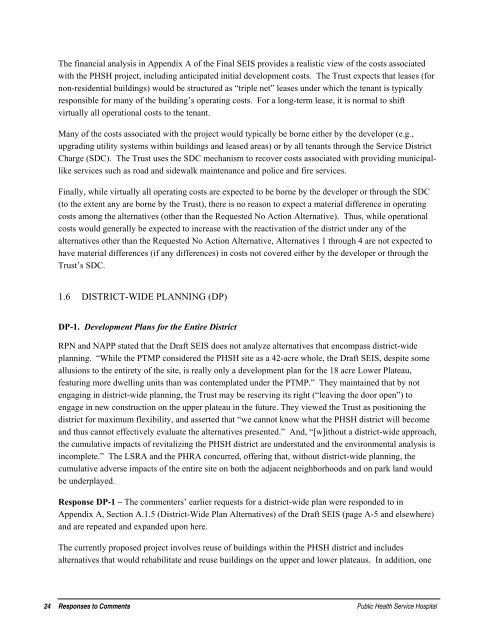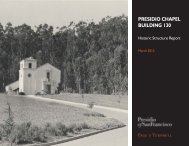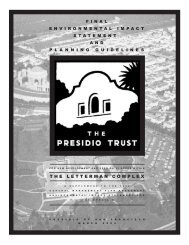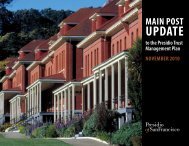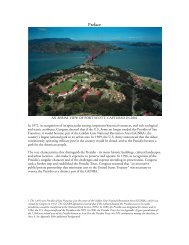Response to Comments - Presidio Trust
Response to Comments - Presidio Trust
Response to Comments - Presidio Trust
Create successful ePaper yourself
Turn your PDF publications into a flip-book with our unique Google optimized e-Paper software.
The financial analysis in Appendix A of the Final SEIS provides a realistic view of the costs associatedwith the PHSH project, including anticipated initial development costs. The <strong>Trust</strong> expects that leases (fornon-residential buildings) would be structured as “triple net” leases under which the tenant is typicallyresponsible for many of the building’s operating costs. For a long-term lease, it is normal <strong>to</strong> shiftvirtually all operational costs <strong>to</strong> the tenant.Many of the costs associated with the project would typically be borne either by the developer (e.g.,upgrading utility systems within buildings and leased areas) or by all tenants through the Service DistrictCharge (SDC). The <strong>Trust</strong> uses the SDC mechanism <strong>to</strong> recover costs associated with providing municipallikeservices such as road and sidewalk maintenance and police and fire services.Finally, while virtually all operating costs are expected <strong>to</strong> be borne by the developer or through the SDC(<strong>to</strong> the extent any are borne by the <strong>Trust</strong>), there is no reason <strong>to</strong> expect a material difference in operatingcosts among the alternatives (other than the Requested No Action Alternative). Thus, while operationalcosts would generally be expected <strong>to</strong> increase with the reactivation of the district under any of thealternatives other than the Requested No Action Alternative, Alternatives 1 through 4 are not expected <strong>to</strong>have material differences (if any differences) in costs not covered either by the developer or through the<strong>Trust</strong>’s SDC.1.6 DISTRICT-WIDE PLANNING (DP)DP-1. Development Plans for the Entire DistrictRPN and NAPP stated that the Draft SEIS does not analyze alternatives that encompass district-wideplanning. “While the PTMP considered the PHSH site as a 42-acre whole, the Draft SEIS, despite someallusions <strong>to</strong> the entirety of the site, is really only a development plan for the 18 acre Lower Plateau,featuring more dwelling units than was contemplated under the PTMP.” They maintained that by notengaging in district-wide planning, the <strong>Trust</strong> may be reserving its right (“leaving the door open”) <strong>to</strong>engage in new construction on the upper plateau in the future. They viewed the <strong>Trust</strong> as positioning thedistrict for maximum flexibility, and asserted that “we cannot know what the PHSH district will becomeand thus cannot effectively evaluate the alternatives presented.” And, “[w]ithout a district-wide approach,the cumulative impacts of revitalizing the PHSH district are understated and the environmental analysis isincomplete.” The LSRA and the PHRA concurred, offering that, without district-wide planning, thecumulative adverse impacts of the entire site on both the adjacent neighborhoods and on park land wouldbe underplayed.<strong>Response</strong> DP-1 – The commenters’ earlier requests for a district-wide plan were responded <strong>to</strong> inAppendix A, Section A.1.5 (District-Wide Plan Alternatives) of the Draft SEIS (page A-5 and elsewhere)and are repeated and expanded upon here.The currently proposed project involves reuse of buildings within the PHSH district and includesalternatives that would rehabilitate and reuse buildings on the upper and lower plateaus. In addition, one24 <strong>Response</strong>s <strong>to</strong> <strong>Comments</strong> Public Health Service Hospital


